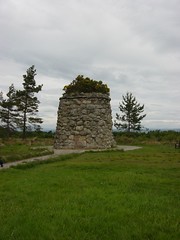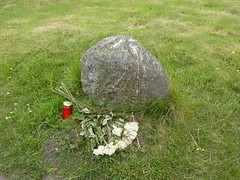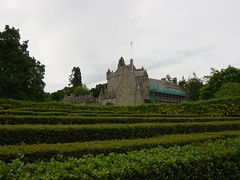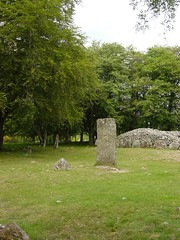Diarist of the Day – Inverness, Scotland
I should first like to start by thanking the anonymous benefactor for whom this is being written. You, whoever you may be, helped make this trip a great success, and helped to make it significantly more affordable for all of us. Thank you.
As a way of expressing our gratitude, each of the students is acting as “Diarist of the Day” for one of the required events on the trip. I was not assigned one of the sites during the trip, so this entry will be a little different from the others. Mrs. H. suggested that I write about one of the days on the extended portion of the trip, and so I shall.
Sharon, Sonoko, Tom, and I were staying at the Cherry Tree Organic B&B, in Inverness. I highly recommend them, as it was clean and comfortable, and the owners, Mr. & Mrs. Prior, were very friendly people. Also, it was very conveniently located, about 5-10 minutes’ walk from the River Ness. Most things in Britain are described as being a 10-minute walk from wherever you happen to be, but I really mean it about this place.
After breakfast, we were planning to visit the battlefield at Culloden Moor, which Jan and Ken had visited the previous day. And while studying the map, I noticed that there was a pre-historic site nearby called “Clava Cairns,” so when I was checking directions with the owners I asked about it. “Is Clava Cairns anything to write home about?” I asked.
“Depends on how you feel about big piles of rocks,” came the reply. Well, despite having been to Stonehenge a few days earlier, we decided that we could stand seeing more rocks. So that went on the agenda. They also warned that it was down some single-track roads, thinking that that might put us off. Not likely! I said, “we just came from Mull.” They agreed that, in that case, the road to Clava Cairns would present no obstacle. Lastly, the Priors suggested that, since it was in the neighborhood anyway, we should visit Cawdor Castle, and that was met with unanimous approval.
So, into the Volvo and off we went. Unfortunately, Michelin does not believe that Inverness is a sufficiently important town to have a detailed map in the atlas, and my memory for directions is not that hot. I lost the highway within a mile. Fortunately, one part of the directions did stick, they said to head toward the hospital, and that was clearly signposted, so after a few scenic detours around town, we were back headed in the right direction.
First stop was Culloden Moor (map). The weather was appropriately atmospheric: drizzling, cool, and breezy. This was the site of the last land battle in Britain, where the dreams of a Stuart restoration were finally dashed. It cost £5 each go into the visitor’s center and cottage, and we all agreed that we’d be happier keeping the money. It seems most people do this, as they were plugging their plans for a new center, which seemed to be designed to force people to visit the center if they wanted to visit the battlefield.
It turned out that between a guidebook and the plaques on the field, it was perfectly easy to get around and understand the battle. The main thing to understand in the battle is that Bonny Prince Charlie was a moron. He picked a battlefield that was wholly unsuited to his infantry’s best attack, and one in which the Duke of Cumberland could use his artillery to its fullest advantage.
It was interesting to see how the memorials were laid out, with the dead of each clan buried together, as far as possible, with clan stones at the head and foot of each mass grave. Legend has it that heather will not grow on the Scots’ graves. Some of the clan and chieftain stones had had wreaths or candles placed in front of them recently.
From the battlefield, we headed for Cawdor Castle, about 10 miles away. This was a real treat. It is also as close as this entry gets to the theme of the class, which was Great Women of Shakespeare's England, as Shakespeare is involved. In Act I, Scene 3 of Macbeth, the witches tell him that he’ll be the “Thane of Cawdor,” and subsequently King Duncan gives him that rank. However, as the Cawdor Castle website points out, the castle was built long after Duncan’s and Macbeth’s time.
By the time we arrived at the castle, the weather had brightened considerably, and it was warm and sunny. At the entrance, we split up. I headed to the gardens, which were superlative. They were more modest in scale than those at Hever Castle or Hampton Court, but every bit as lovely. In fact, they and the castle itself, reminded me of Wilton House, with a very informal yet elegant character.
The only great disappointment for me in the gardens was that the maze, which was planted with holly, was closed. I still have not managed to visit one of these hedge mazes in Britain. Maybe on the next trip.
Finally, I went into the castle, which was quite nice. Like Wilton House, the castle is still owned by the family, and used as a residence part of the year. In this case the Dowager Countess of Cawdor spends the winter at the castle, and most of the rooms had her books and artwork sprinkled around. It really gave me a feeling of how the other half lives. In each room, there were notes describing the paintings or furnishings, which were written by the Fifth Earl Cawdor with a mixture of wry humor and pride.
I had lunch at the castle restaurant. I asked about the soups, and was given a choice between sweet potato soup and leek. I chose the leek, because I despise sweet potatoes, but was served this frightening orange goo. When I asked the server if he was sure that was leek, and not sweet potato, he froze in confusion and asked one of the cooks. She came out and showed him the orange goo and the other soup, which was a clear broth with leeks in it, and heaped abuse upon him for not being able to tell the difference. I was sorry to get him in trouble, but I must admit it was hilarious.
Went back to the car and met up with the others, they had visited the castle first, and then the gardens, and we all raved about how much we liked them. Finally, we headed for the Clava Cairns. Despite the warning about the single-track roads, we were only on them for about a mile, and didn’t come across any traffic.
The site consists of three large cairns, surrounded by standing stones, and one smaller ring of boulders (pdf guide). Two of the cairns were “passage graves” which were aligned so that the setting sun on the winter solstice would illuminate the grave chamber. Their shape is reminiscent of the “C” on the Colorado State flag. The third cairn is a closed ring, which was not used for a burial. One of the standing stones struck me as particularly noteworthy, it was a granite monolith about eight feet high, and looked for all the world like the Monolith from 2001: A Space Odyssey.
The cairns are in a lovely valley, with farmland surrounding them and it was a very picturesque and quiet setting. This is one thing that the Cairns have over Stonehenge – here there were only about a dozen people visiting, and only 3 cars in the parking lot. Quite a change from the mass mayhem at Stonehenge.
Finally, we worked our way back to Inverness, for a little un-structured free-time. All in all, this was one of the most interesting days of the trip for me, as we dealt with three very different periods in British history: the modern battlefield at Culloden, the Medieval castle and its aristocratic ties, and the pre-historic societies that built stone-circles.





<< Home